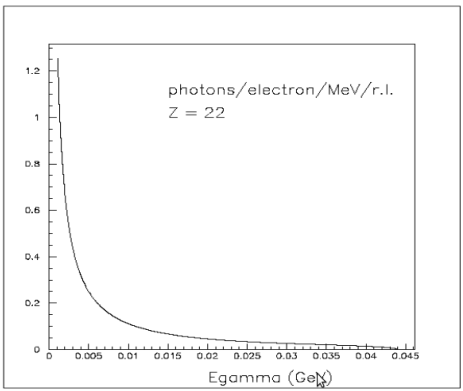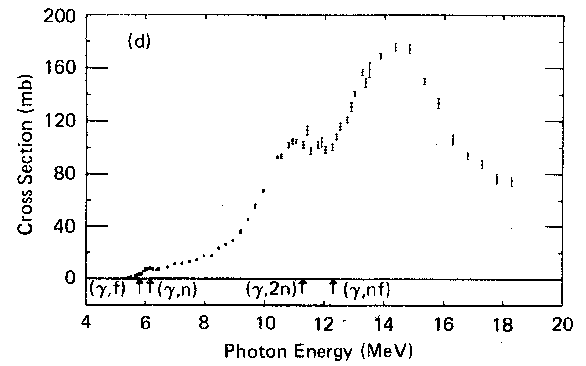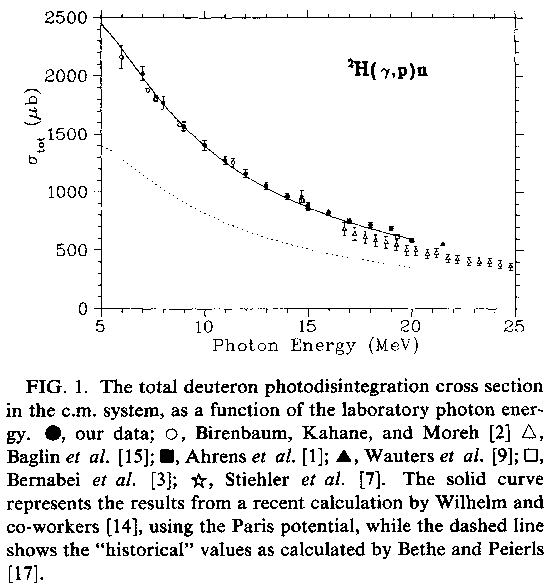Difference between revisions of "Counts Rate (44 MeV LINAC)"
(→Yield) |
|||
| Line 116: | Line 116: | ||
<math> 53.8\ \frac{neutrons}{sec} \times \frac{1\ sec}{300\ pulses} = 0.18\ \frac{neutrons}{pulse} </math> <br><br> | <math> 53.8\ \frac{neutrons}{sec} \times \frac{1\ sec}{300\ pulses} = 0.18\ \frac{neutrons}{pulse} </math> <br><br> | ||
| − | 53.8 neutrons/sec <= this experiment is do able | + | ''53.8 neutrons/sec <= this experiment is do able'' |
| − | 0.18 neutrons/pulse <= | + | ''0.18 neutrons/pulse <= good for stopping pulse'' |
=Counts Rate for U238 (25 μm Al converter)= | =Counts Rate for U238 (25 μm Al converter)= | ||
Revision as of 04:05, 29 May 2010
Counts Rate for U238 (0.5 mil Ti converter)
LINAC parameters used in calculations
1) pulse width 50 ps
2) pulse current 50 A
3) repetition rate 300 Hz
4) energy 44 MeV
Number of electrons/sec on radiator
Number of photons/sec on target
bremsstrahlung
in (10,20) MeV region we have about
0.1 photons/electrons/MeV/r.l
radiation length
r.l.(Ti) = 3.59 cm
radiator thickness = 12.5
steps together...
Alex factor (GEANT4 calculation)
Collimation factor is
6.85 % of total # of photons
then, incident flux on target is
Number of neutrons/sec
photonuclear cross section for reaction
J. T. Caldwell et all., Phys. Rev. C21, 1215 (1980):
in (10,20) MeV region the average cross section, say, is:
130 mb
target thickness,
Let's target thickness = 1 mm:
neutrons per fission
2.4 neutrons/fission
steps together...yeild
Worst Case Isotropic Neutrons
checking detector distance
we want:
the time of flight of neutron >> the pulse width
take the worst case 10 MeV neutron:
take the neutron detector 1 meter away:
23 ns >> 50 ps <= time resolution is good
geometrical factor
taking real detector 3" x 2" => S is about 40 cm^2
1 meter away
fractional solid angle = <= geometrical acceptance
Yield
the yield per second:
the yield per pulse:
53.8 neutrons/sec <= this experiment is do able
0.18 neutrons/pulse <= good for stopping pulse
Counts Rate for U238 (25 μm Al converter)
Counts Rate for Deuteron
photonuclear cross section for reaction
A. De Graeva et all., Phys. Rev. C45, 860 (1992):
in (10,20) MeV region the average cross section, say, is:
1000 μb
target thickness,
take , liquid (20°C):
Let's target thickness = 10 cm:
Calibration factor
The only difference from calculations above is:
1) cross section:
1000 μb (D) / 130 mb (238U) = 1/130
2) target thickness:
3) neutrons per reaction:
1 neutron (D) / 2.4 neutrons(238U) = 1/2.4
4) geometrical factor:
assume for now is 1
total calibration factor is:
Yield
saying all other factors is the same =>
the yield per second :
the yield per pulse:


